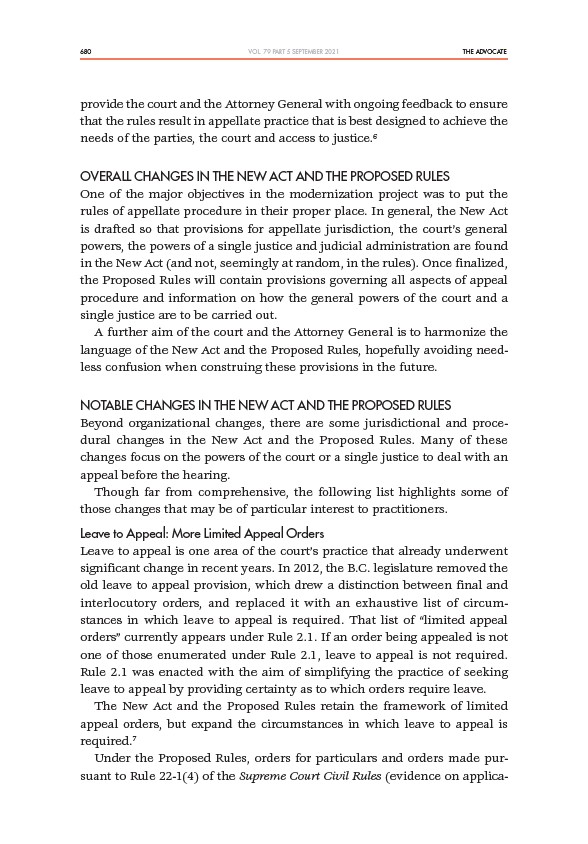
680 THE ADVOCATE
VOL. 79 PART 5 SEPTEMBER 2021
provide the court and the Attorney General with ongoing feedback to ensure
that the rules result in appellate practice that is best designed to achieve the
needs of the parties, the court and access to justice.6
OVERALL CHANGES IN THE NEW ACT AND THE PROPOSED RULES
One of the major objectives in the modernization project was to put the
rules of appellate procedure in their proper place. In general, the New Act
is drafted so that provisions for appellate jurisdiction, the court’s general
powers, the powers of a single justice and judicial administration are found
in the New Act (and not, seemingly at random, in the rules). Once finalized,
the Proposed Rules will contain provisions governing all aspects of appeal
procedure and information on how the general powers of the court and a
single justice are to be carried out.
A further aim of the court and the Attorney General is to harmonize the
language of the New Act and the Proposed Rules, hopefully avoiding needless
confusion when construing these provisions in the future.
NOTABLE CHANGES IN THE NEW ACT AND THE PROPOSED RULES
Beyond organizational changes, there are some jurisdictional and procedural
changes in the New Act and the Proposed Rules. Many of these
changes focus on the powers of the court or a single justice to deal with an
appeal before the hearing.
Though far from comprehensive, the following list highlights some of
those changes that may be of particular interest to practitioners.
Leave to Appeal: More Limited Appeal Orders
Leave to appeal is one area of the court’s practice that already underwent
significant change in recent years. In 2012, the B.C. legislature removed the
old leave to appeal provision, which drew a distinction between final and
interlocutory orders, and replaced it with an exhaustive list of circumstances
in which leave to appeal is required. That list of “limited appeal
orders” currently appears under Rule 2.1. If an order being appealed is not
one of those enumerated under Rule 2.1, leave to appeal is not required.
Rule 2.1 was enacted with the aim of simplifying the practice of seeking
leave to appeal by providing certainty as to which orders require leave.
The New Act and the Proposed Rules retain the framework of limited
appeal orders, but expand the circumstances in which leave to appeal is
required.7
Under the Proposed Rules, orders for particulars and orders made pursuant
to Rule 22-1(4) of the Supreme Court Civil Rules (evidence on applica-